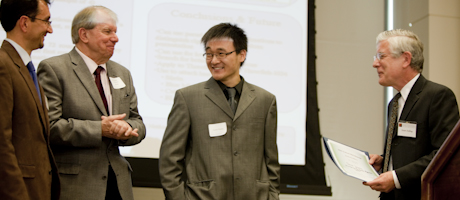There’s a household in Beijing that’s in for some excitement.
TaiSen Zhuang, who’s pursuing a Ph.D. in micropropulsion, says he’ll be planning a visit to his hometown—to “give my mom and dad a surprise”— after winning the $2,000 first-place prize in the School of Engineering and Applied Science’s research and development showcase, held on April 30.
He usually gets home only once a year; now Mr. Zhuang says the prize money will cover airfare for an extra trip, hopefully this summer.
Mr. Zhuang’s cigarette-sized thruster for propelling small, cube-shaped satellites—for which his team recently applied for a patent—was vying this year against dozens of other research projects conducted by SEAS undergraduate and graduate students.
Competitors included a study to determine the best temperature for bacteria to digest D.C. wastewater sludge, an evaluation of optical/acoustic radiation imaging for soft tissues of the body, and a design for a tank-like robot with an extending arm and claw, which could be used by the military or for explorations of sea and space.
Speaking at the event, Vice President for Research Leo Chalupa noted that GW’s 2009 expenditures on sponsored projects—dedicated funding, like last month’s $4.6 million grant to provide training in health information technology—will likely put the university somewhere just over No. 100 in upcoming rankings. However, he anticipated the university would be able to increase that spending more than 40 percent by 2014.
“Everyone I talk to—from the board of trustees, to President Knapp, to people in the senior leadership, to the deans—they want this to happen,” he said. “So there’s unanimous agreement: we will get better science funding.”
In five years, Dr. Chalupa said he envisions GW’s spending rank to climb into the 80s. “And my guess is that’s just the start,” he said. “In five to 10 years, we’re going to crack the top 50. This is a very good engineering school; five to 10 years from now it’s going to be a phenomenal engineering school.”
The showcase’s second-place prize of $1,200 went to Huda Asfour, a Ph.D. student in biomedical engineering. She presented an imaging process developed by her lab that allowed them to better capture and analyze data on the electrical activity and metabolism of a beating rat heart.
The $800 prize for third place went to Autumn Glenn, who is pursuing a master’s in mechanical engineering, for her research on blood flow around stents—devices used to hold open arteries and other structures in the body—that could lead to a better design.
She admitted to being a little taken aback with the award. “Everyone else’s posters were so good. Stiff competition.”


